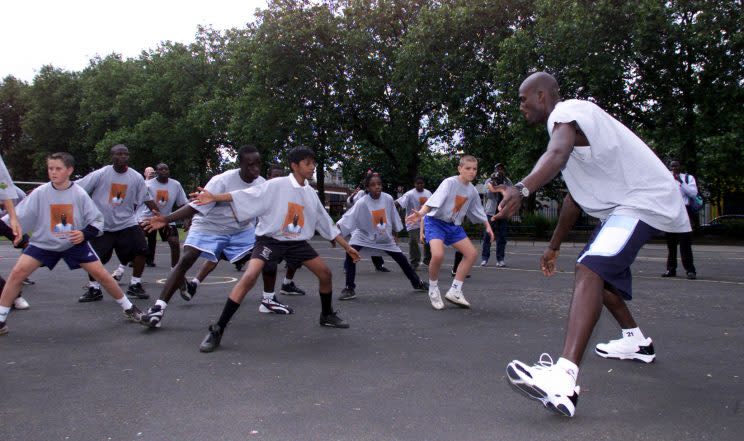How Kevin Garnett's fire, intensity changed the league
In the spring of 1995, Kevin Garnett was something of an unknown. Teams were aware of the spindly, 6-foot-11 phenom, but interest was lukewarm. Late first round, maybe second was the buzz, and only if a general manager, not yet used to the idea of drafting high school talent, was willing to take on a project. In May, Garnett held a workout. He invited representatives from the lottery teams, including two — Kevin McHale and Flip Saunders — from Minnesota.
McHale was there — grudgingly. “I thought it was a waste of time,” McHale recalled recently. The Timberwolves’ first-year GM knew of Garnett, liked him, but didn’t think for a second he would burn the fifth overall pick on him. Then Garnett began to work. The power forward who spent years overwhelming overmatched opponents with power moves was suddenly dribbling, spinning and shooting like a guard. When it was over, McHale and Saunders piled into a car, looked at each other and expressed the same thing: That’s our guy.
Minnesota drafted Garnett, beginning a decorated 21-year career that ended Friday, with Garnett, 40, negotiating a buyout of the final year of his contract with the Timberwolves and announcing his retirement. We’ve seen the last of Kevin Garnett thumping his chest, sneering at the crowd and spewing trash talk that should come with an NC-17 rating, and it’s time. Past time, really. It should have ended in 2013, in Boston, in the sports-starved city Garnett fed for six seasons. “People don’t know how close KG was [to retiring],” Paul Pierce told The Vertical recently. “He was done.” It was Pierce, knowing the Celtics stars were about to be sold off, desperate to build a title-ready contender elsewhere, who persuaded Garnett to come to Brooklyn, to squeeze more out of his breaking-down body.

Garnett did and toiled for three more seasons, splitting time between Brooklyn and Minnesota, the state where it all began. Age ends things for all, but it was tough to watch a player renowned for his refusal to come off the floor — practice or otherwise — limited to 20 minutes per game, to see one of the great defensive players of this generation yanked late in games for defensive replacements. The fire that burned inside Garnett for 21 seasons still burned, but the body that battled through 1,605 NBA games and the knees that pushed through 55,701 minutes had betrayed him.
The list of transformative stars is a long one, but how many can say they transformed two franchises along the way? Garnett’s legacy in Minnesota won’t include a championship, and we will always wonder what could have been had Stephon Marbury not forced his way off the Timberwolves after two-plus seasons as KG’s running buddy. But Garnett gave a fledgling franchise relevance and drove it to eight straight playoff appearances — including one trip to the Western Conference finals. Boston, too, was floundering when Garnett was traded there in 2007. His partnership with Pierce and Ray Allen yielded one title and the unflinching belief that there could have been more had injuries not derailed the Celtics along the way.
Garnett has influenced so many. He practiced as he played, because, well, that’s what leaders do. Those who didn’t weren’t likely to last. Take Patrick O’Bryant. In 2008, Boston signed the skilled center, a top-10 draft pick just two years earlier. Early on Garnett pushed him. When O’Bryant didn’t respond, Garnett pushed harder. Still nothing. Four months later, O’Bryant was gone, dumped to Toronto for a second-round pick. Last year, Clippers coach Doc Rivers, who coached Garnett with the Celtics, was asked to compare Garnett’s intensity to Chris Paul’s. They were similar with intensity and preparation, Rivers said, “but Kevin was insane.”
Teammates hid from Garnett before games because exhibiting anything short of a laser-like focus was unacceptable. Headphones that blared a little too loud were likely to draw Garnett’s ire. Rajon Rondo thrived under Garnett’s wing while Kendrick Perkins adopted Garnett’s surly personality. In 2006, Lindsey Hunter, then a veteran guard in Detroit, came off the floor after an early season game against Boston with a quizzical look. “What’s up with Perkins?” Hunter asked. “Last season he was this quiet guy. Now he’s, ‘[expletive] this and [expletive] that.’ ” That was all KG.
Rookies felt Garnett’s wrath. Some used to wake up on the road in the middle of the night to phone calls from KG. I need soap. Go get me some soap. So they would hop into a cab, find an open CVS and get Garnett the soap he asked for.
Garnett was a mentor for Minnesota’s young stars last season, but privately team officials would tell you: It wasn’t the same. Karl-Anthony Towns, Andrew Wiggins and Zach LaVine grew up revering Garnett, but there’s only so much influence words can have from a player who can no longer step on the floor to reinforce them. Yet the lessons linger. In an interview with ESPN’s Jackie MacMullan last year, Garnett said a repeated message to the young Timberwolves was to not let ego fracture them, like it did Garnett and Marbury. Indeed, two decades after building the foundation of a successful era in Minnesota, Garnett has had a hand molding those that will shape the next one.
More NBA coverage from The Vertical:


